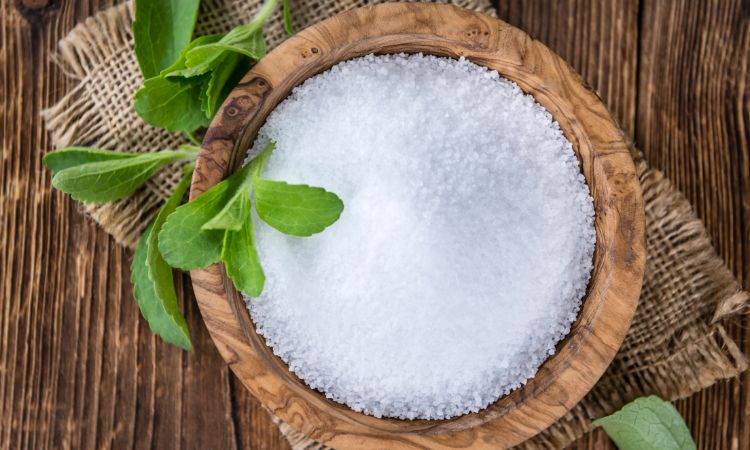Stevia Market Overview
The global stevia market is experiencing significant growth due to rising consumer demand for natural, low-calorie sweeteners. Stevia, a plant-derived sweetener, offers a healthier alternative to sugar and artificial sweeteners, catering to the increasing awareness of health and wellness. Its natural origin, zero-calorie content, and versatility in food and beverage applications contribute to its popularity. The market’s expansion is driven by the growing trend of reducing sugar intake and the increasing adoption of stevia in various industries, including food and beverages, pharmaceuticals, and personal care products.
Stevia Market Size
In 2023, the global stevia market was valued at approximately USD 843.19 million. The market is projected to grow significantly during the forecast period from 2024 to 2032, with an expected compound annual growth rate (CAGR) of 10.7%. By 2032, the market is anticipated to reach a value of USD 2114.51 million. This robust growth is attributed to the rising consumer preference for healthier sugar alternatives and the increasing use of stevia in diverse product formulations across multiple industries.
Stevia Market Share
The stevia market’s share is expanding as consumers increasingly shift towards healthier dietary choices. Key players in the market are focusing on enhancing their product portfolios and geographic reach to capture a larger market share. North America and Europe are leading regions in the market due to high health consciousness and regulatory support for natural sweeteners. Meanwhile, the Asia-Pacific region is emerging as a significant market due to the increasing adoption of stevia in food and beverage products, driven by rising disposable incomes and changing lifestyles.
Stevia Market Trends
Several key trends are shaping the stevia market:
- Health Consciousness: Growing awareness of health and wellness is driving demand for low-calorie, natural sweeteners.
- Product Innovations: Companies are introducing new stevia-based products and blends to cater to diverse consumer preferences.
- Regulatory Support: Increasing regulatory approvals and support for stevia-based products are fostering market growth.
- Expanding Applications: Stevia is being used in various applications, including food, beverages, pharmaceuticals, and personal care products.
- Sustainability: There is a rising emphasis on sustainable and eco-friendly production methods within the industry.
Stevia Market Analysis
The stevia market is characterized by its rapid growth and dynamic nature. The shift towards healthier lifestyles and dietary choices is driving the demand for natural sweeteners. Stevia, with its zero-calorie content and natural origin, fits well into this trend. Market players are focusing on expanding their product offerings and geographical presence to tap into emerging markets. The competitive landscape features several key players who are investing in research and development to enhance product quality and innovation. The market’s growth is also supported by increasing consumer awareness and favorable regulatory frameworks for natural sweeteners.
Stevia Market Segmentation
- By Form:
- Powder: Popular for its versatility in various food and beverage products.
- Liquid: Preferred for ease of use in beverages and recipes.
- Tablets: Convenient for direct consumption and portion control.
- By Application:
- Food and Beverages: Largest segment, including products like soft drinks, dairy, and baked goods.
- Pharmaceuticals: Used in medicines and supplements for its sweetening properties.
- Personal Care Products: Incorporated into oral care and skincare products.
- By Distribution Channel:
- Online: Growing due to convenience and wider product selection.
- Offline: Includes supermarkets, hypermarkets, and specialty stores.
- By Region:
- North America: Leading market due to high demand for natural sweeteners.
- Europe: Significant growth driven by health trends and regulatory support.
- Asia-Pacific: Emerging market with increasing adoption and consumption.
Stevia Market Growth
The stevia market is set for substantial growth, driven by increasing consumer demand for natural and healthier alternatives to sugar. The market’s growth is supported by a CAGR of 10.7% from 2024 to 2032, reflecting the rising awareness of health benefits and the expanding application of stevia in various sectors. Key growth factors include the increasing prevalence of diabetes and obesity, which are prompting consumers to seek low-calorie sweeteners. Additionally, ongoing innovations in stevia products and favorable regulatory conditions are contributing to the market’s expansion.
Recent Developments and Challenges in the Stevia Market
Recent Developments:
- Product Innovation: Companies are developing new stevia formulations and blends to enhance taste and functionality.
- Regulatory Approvals: Increased regulatory support and approvals are facilitating market growth and product launches.
- Sustainability Initiatives: Companies are focusing on sustainable production practices and eco-friendly packaging.
Challenges:
- Cost Fluctuations: Variability in raw material costs can impact the pricing and profitability of stevia products.
- Taste Profile: Some consumers find the taste of stevia less desirable compared to traditional sweeteners.
- Regulatory Hurdles: Navigating regulatory requirements across different regions can be complex and time-consuming.
Key Players
- Layn Corp.: A major player in the stevia industry known for its extensive product range and global presence.
- Cargill, Incorporated: A leading multinational corporation offering a variety of stevia products and solutions.
- ADM: A key player in the food and beverage sector with a focus on stevia and other natural sweeteners.
- Ingredion Incorporated: Provides a range of stevia products and is known for its innovation in the sweeteners market.
- Tate & Lyle: Offers a diverse portfolio of sweeteners, including stevia, with a focus on health and wellness.
- GLG Life Tech Corporation: Specializes in the production of high-quality stevia extracts.
- Pyure Brands LLC: Known for its pure stevia products and commitment to natural sweeteners.
- Sunwin Stevia International Inc: A major player in the stevia market with a focus on high-purity extracts.
- Steviva Brands, Inc.: Offers a wide range of stevia-based sweeteners and blends.
- Zhucheng Haotian Pharm Co., Ltd. (“HOWTIAN”): A key manufacturer of stevia extracts in Asia.
- MORITA KAGAKU KOGYO CO., LTD.: Known for its stevia products and contributions to the sweetener market.
- Wisdom Natural Brands: Provides a variety of stevia products and is known for its commitment to quality.
- SweeGen, Inc: Offers innovative stevia solutions with a focus on taste and performance.
- Hunan NutraMax Inc.: A significant player in the stevia market with a range of natural sweeteners.
- The Real Stevia Company: Specializes in authentic stevia products and natural sweeteners.
FAQ for Stevia Market
Q1: What is stevia?
A1: Stevia is a natural sweetener derived from the leaves of the Stevia rebaudiana plant. It is known for its zero-calorie content and is used as a sugar substitute in various food and beverage products.
Q2: What is driving the growth of the stevia market?
A2: The growth of the stevia market is driven by increasing health consciousness, rising demand for natural sweeteners, regulatory support, and innovations in stevia products.
Q3: What are the key applications of stevia?
A3: Stevia is used in food and beverages, pharmaceuticals, and personal care products. Its versatility allows it to be used in a wide range of products, including soft drinks, baked goods, and oral care products.
Q4: Which regions are leading in the stevia market?
A4: North America and Europe are leading regions due to high health awareness and regulatory support. The Asia-Pacific region is also emerging as a significant market due to increasing adoption and rising disposable incomes.
Q5: What are the major challenges faced by the stevia market?
A5: Major challenges include cost fluctuations of raw materials, taste profile issues compared to traditional sweeteners, and complex regulatory requirements across different regions.




